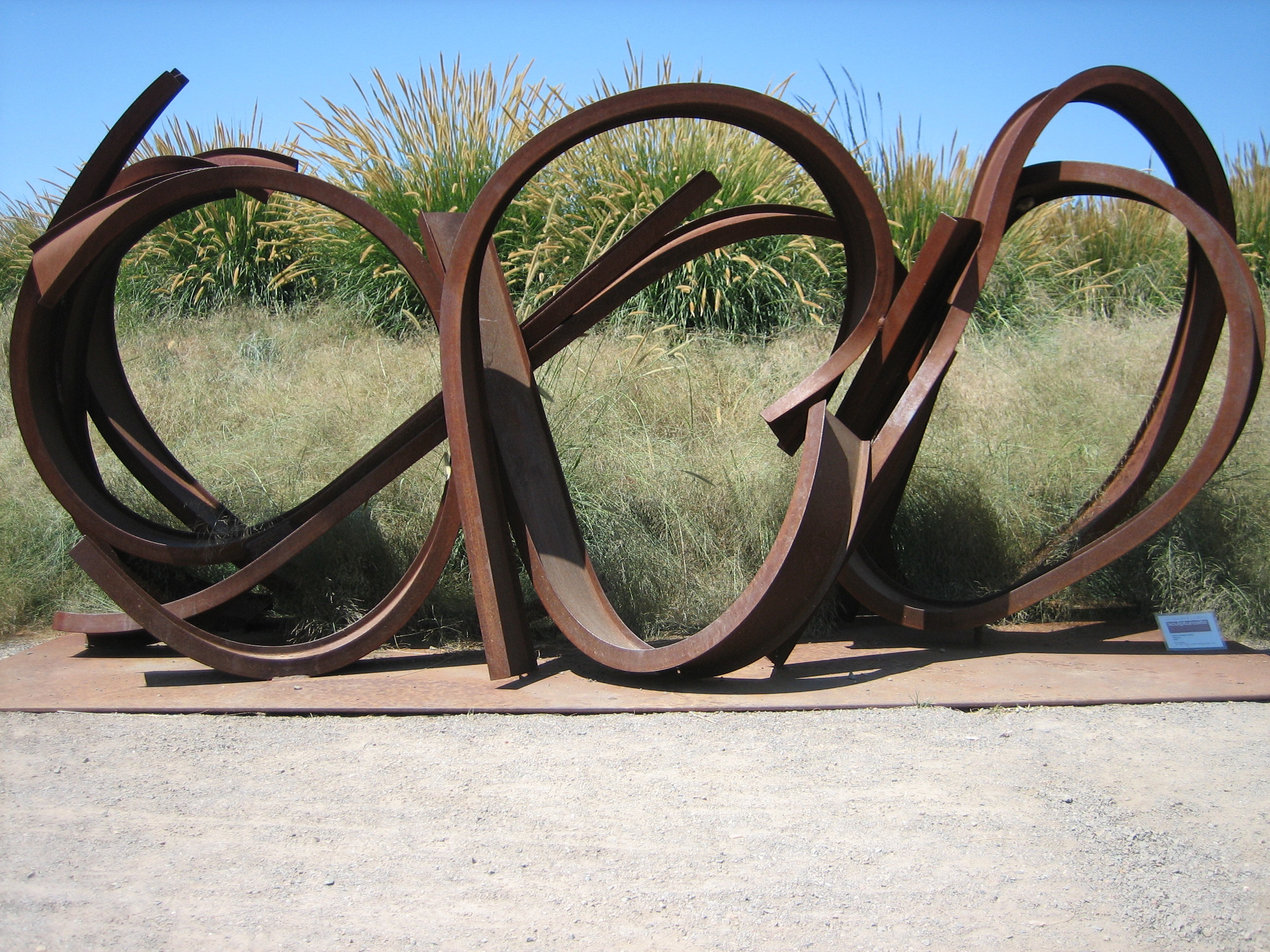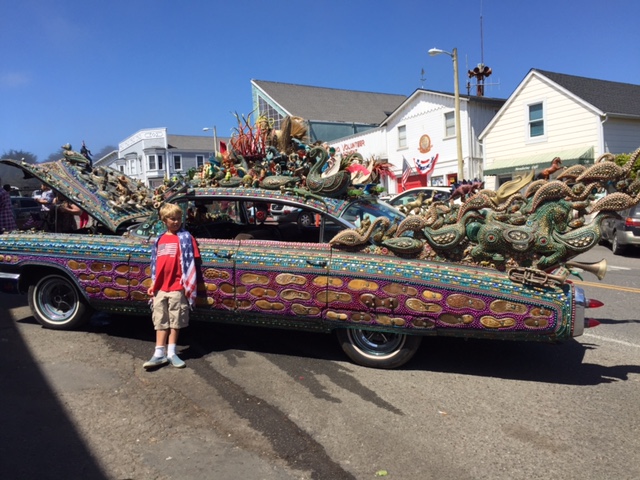Mysterious, Dreamy, and Erotic Art: Collages by S.R. Jones
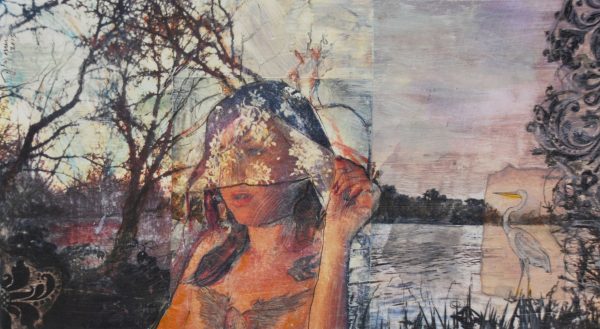
Could the mastery of collage be the next big wave in today’s ever-changing art world where the appetite for the new and different is relentlessly competitive? For Sacramento artist S.R. Jones, that would be ideal. We’re not talking second grade cut-and-paste projects; we’re talking well thought out, imaginative and poetic collages. Jones’ exquisite works are the result of layers of mixed media assembled by a skillful hand and an artistic eye. The skillful hand comes from a formal education in fine arts and years of work in the interior design business, where Jones is the last of a dying breed of hand draftsmen. The artistic eye was honed over a lifetime immersion in art practice.
As the principal of his own Sacramento based design firm, designTECH, Jones’ creativity has proven successful, but is somewhat limited by the parameters of the business: budgets, timelines, client’s objectives and vision. Juxtaposed to that environment is his other life as an artist, where he is free to explore and make any art form he chooses.
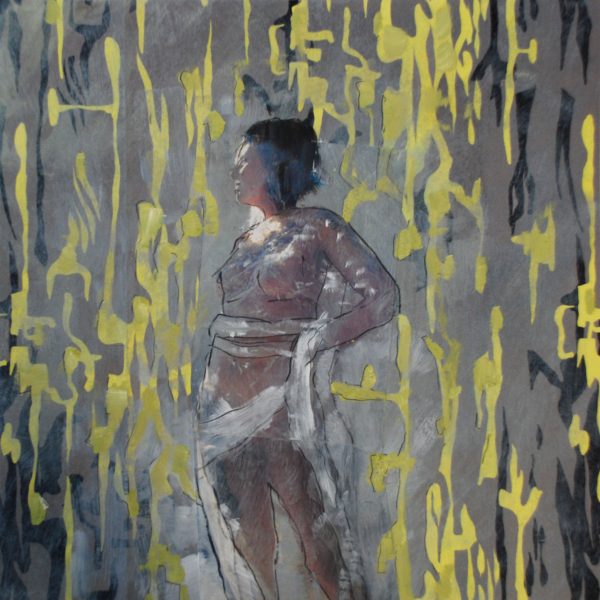
“Rumble,” S. R. Jones, 2015. Oil and graphite on color print and wrapping paper, 12″ x 12″.
Jones has chosen collages. Specifically collages that lean toward the figurative by incorporating the female form, photographed and painted, then layered with other materials from his expanding collection of found objects. Jones has said his work, “evokes a mysterious narrative.” A discussion of that narrative and other aspects of his work and career appear below.
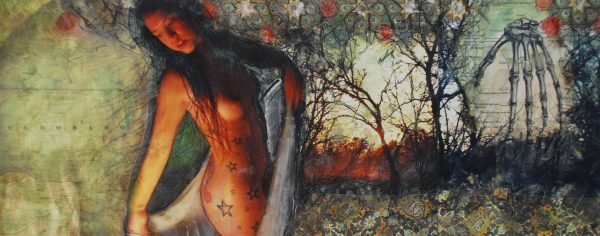
“El Dorado,” S.R. Jones, 2015. Oil and graphite on artist’s photos, map, giftware, and book page (on paper), 9″ x 23″
LS: There are a lot of photographs in your work. Are you a photographer?
SRJ: I never describe myself as a photographer because I’m not a trained photographer, especially compared with photographers who are really smart about photographic techniques and settings and mechanisms. It’s just not my thing. Many times photographers are either purists or technical geniuses. I’m just not in that category. I use photos just as a means to an end, as raw material, and then incorporate those into collages.
LS: How would you describe yourself?
SRJ: As an artist. I was trained as an artist, primarily in printmaking. Although I don’t print make anymore, I still like to make art. I still like to hang with artists. I still like to show art. And those are all bonuses. I’m always going to make art for myself. I don’t consider myself a colorist. I’m certainly not conceptual.
LS: So you don’t really fit into one category because you photograph, you paint and you sketch.
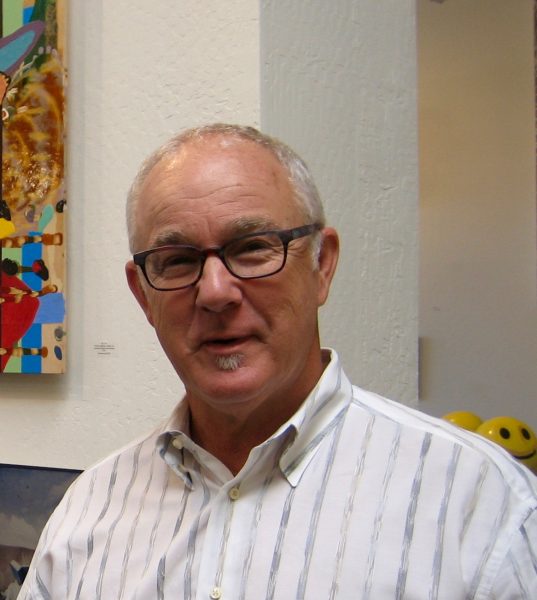
Collage artist S.R. Jones, 2016.
SRJ: Yes, I like to do all three things. I like to use photography, as I said, as a means to an end. And sometimes I’ll use other people’s photos. Lately I’ve been getting photos from Instagram friends and collaborating with them. For example, the three pieces up at JayJay (JayJay Gallery, Sacramento), I’ve never met that person who took the photos; they’re from Instagram. I also like to do live studio drawing. I do that at least twice a month just to keep my hand trained.
LS: With a model?
SRJ: Yes, with a model. I’ll get together with some and friends and hire a model. A group of us will try to do that just to keep loose and keep our hand and our eye coordination going. One person works in watercolors and she’s very talented. Another works in a variety of media and she’s outrageously talented. And I kind of just clunk along in the back, sketching. In my work I employ sketching. I love to paint in oil — I don’t care for acrylics — and I’ll slather some oil, then I’ll sketch over the top of that, and then I might sand over that.
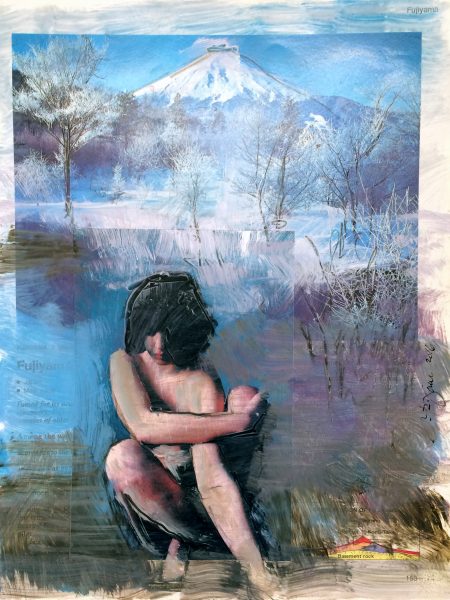
“Fujiyama,” S. R. Jones, 2016. Oil and graphite on color print and found paper, 10″ x 8″.
LS: Do you start with a blank canvas?
SRJ: No, never. I always work on a photo or on some other areas of the collage. Maybe I’ll use some found objects and found paper. I get a lot of paper out of old textbooks or history books or encyclopedias. A blank canvas is not enjoyable for me unless I’m doing a life drawing. If I were to approach a blank canvas with my paint, and sketch, it’s not enough information for me to riff off. I’d much rather play off some of the imagery that’s already been established.
LS: Is there a particular process that you follow? And what tools and materials are most important in your work?
SRJ: The process is this: I’ll do a photo session with a model, taking the photos with a Polaroid, through a 4 x 5 camera. Or I’ll shoot with a camera like yours (point and shoot), or even an Iphone. Then I’ll print those photos and throw them into a flat file in my studio. The next time I work — I work sporadically — I’ll go through some books and tear out the pages I think are interesting and throw those in the flat file. A lot of times I use textbooks, or natural history books of some kind, or zoology books with weird stuff. I’ll rip out all of the pages that I think are compelling. Then I have some raw material. My friends will tell you that I’m always picking up stuff off of the street: found objects and throwing those in the flat file.
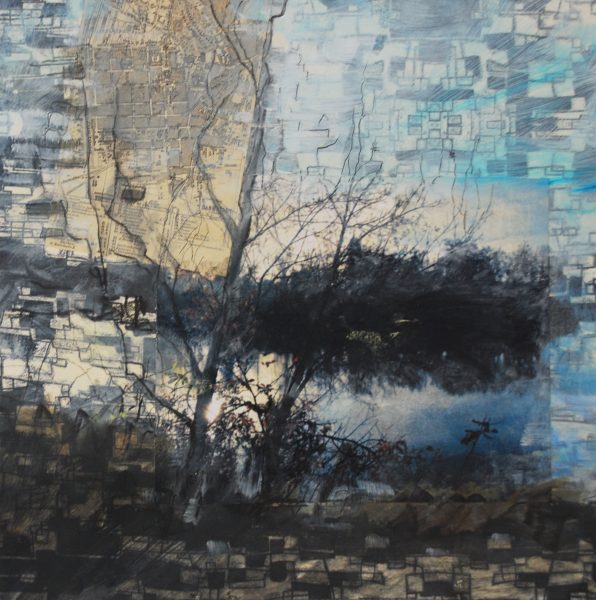
“Everything Inside Screams for a Second Life,” 2016, S.R. Jones. Oil and graphite on artist’s photo, antique map, giftwrap (on paper), 12″ x 12″
When it’s time to actually start the collage, I’ll go through and start adding these things as sort of the base layer. Next I glue it all together. I might sand some stuff down because I like texture and it also gives the paper a better tooth for the oil to adhere to. The next time I work on it, I’ll start sketching on it and add some more paint. Then I let that dry. It becomes a layered process. I think my training as a printmaker allows me to be real comfortable with a layer, and then another layer, and another layer. It’s a lot easier and more satisfying for me to work in layers then it is to address a blank canvas and just start in.
LS: And you like the results?
SRJ: Love it, love it. And I love the process. Now it could be said that I love it too much because I haven’t ventured too far out of that process in the last 10 to 15 years. I like doing that. It’s comfortable.
LS: When you extract something from a book, are you ripping it, or carefully cutting with scissors?
SRJ: I’m ripping it because it’s totally raw material. When you think of collage artists that are carefully cutting out little things, or carefully putting together everything perfectly aligned — eh, my stuff is a lot more sloppy than that. Although I’m slapping it together, I still want it to line up and I still want it to be the right scale. I want to create a mood, imply this movement, and imply this sort of foggy vision. Not something that is fussy.
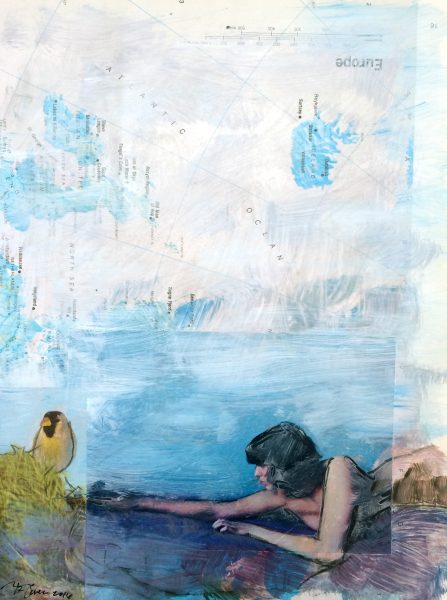
“Europe,” S. R. Jones, 2016. Oil and graphite on color print and found paper, 10″ x 8″.
LS: Do you have a subject in mind when you begin a specific work?
SRJ: The short answer is no. The longer answer is: I love figures. I especially I love to draw female figures. That’s the most beautiful thing there is. And the next most beautiful thing is landscapes. I’m always trying to capture beauty but at the same time a feeling. With the found objects and the other collage materials I’m using, I’m just trying to bring about a feeling. And I’m always, always listening to music when I work.
LS: What kind of music?
SRJ: It varies. A lot of it is alternative. Usually it’s some kind of love song or the blues. The music will put me into a certain frame of mind when I’m working. Then I start thinking of the title of the piece I’m working on. Eight times out of ten, my pieces are titled with a line, a lyric, or a thought from a song. That’s because I think songwriters have the closest thing to poetry that I’m going to read, or the closest thing to literature that I’m going to read. I like non-fiction and don’t read fiction.
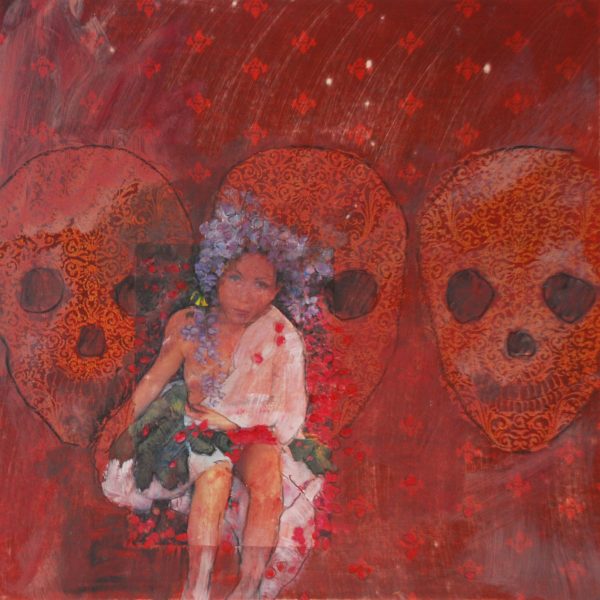
“Before We Count Up What This Will Cost,” S. R. Jones, 2015. Oil and graphite on color print and wrapping paper, 12″ x 12″.
LS: Does your work have a message or is there something you want the viewer to get from your work?
SRJ: Sometimes it has a message: more often then not, no. I’m just trying to convey a feeling. My pieces are more visual. A lot of times they are just pretty things for me to make and look at, or for other people to look at. But if they can bring about a feeling of mystery, I like that. And if they really evoke a feeling within the viewer — it might not be the exact feeling I have — but we’re heading in the right direction.
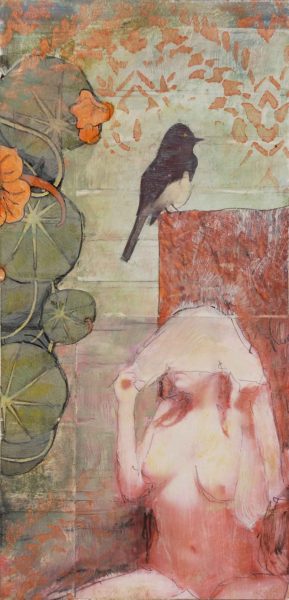
“Courtier Les Muses,” S.R. Jones, 2015. Oil and graphite on artist’s photo, book page, giftware (on panel), 9.5″ x 4.5″
LS: Do you work on your art every day? How much time goes into your work at designTECH versus, artwork and personal time?
SRJ: I work anywhere from 40 to 50 hours a week at designTECH, which is my day job. If I’m teaching, which I am this semester (at California State University, Sacramento), then that’s another two half-days a week. And then I add a few hours of prep work outside of class. Then I’ll throw in some adventure time and extra curricular art activities. My artwork kind of gets the back seat of the bus.
LS: Did you always want to be an artist? As a kid did you draw or paint?
SRJ: All the time. I don’t know how it started. But I can remember as far back as kindergarten. Everybody else was building with blocks or playing in the sandbox. I was at the easel with paints every day. I don’t know why. But that’s what I did. When I had spare time in grammar school, I drew. When I was in high school, I took art every semester. When it came time to declare a major in college, I declared art because that’s what I loved.
LS: Who or what influences your work?
SRJ: Travel, music, and other artists. Classical art, of course. And the Surrealists. Joel Peter Witkin, the photographer, whose stuff was so weird, influences me. If you look at some of his photographs, you can see that he scratched plates and negatives. His photos have this real otherworldly feel about them. He’s influenced me to sand my pieces. I’m more influenced by photographers, rather then painters or other artists.
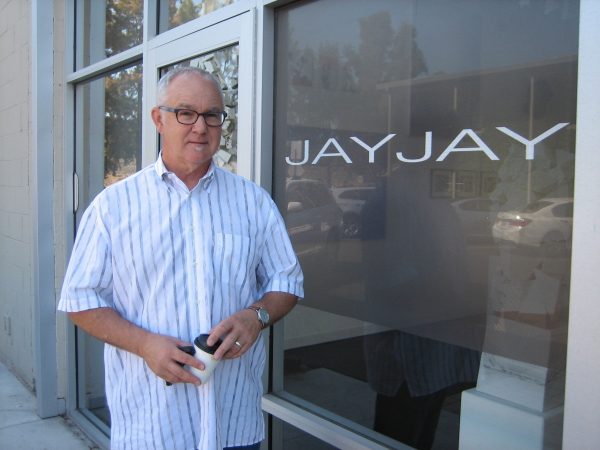
Collage artist S. R. Jones at Jay Jay Gallery, Sacramento, October 2016.
LS: Your wife, Beth Jones, is the co-owner of the art gallery JayJay. How does she influence your work?
SRJ: There may be some artists who don’t like third parties as a filter. And they don’t like their gallery affiliates giving them feedback. In my case I love it. I’m in the studio working on a piece, and get so enmeshed and so close to the project that I can’t really see the piece. I’ll take the work, when it’s about 50 percent done, to Beth and her gallery partner Lynda Jolley. And they will tell me if it’s terrible. I don’t have thin skin about it. I want that feedback. I love the fact that I get to use them as a sounding board for my work. It just makes it easier for me. They have enough experience to know if a piece is weak or if it has some merit.
LS: Your work strikes me as very original and creative and different. It’s really unique. I haven’t really seen anything like your art. I can’t even remember the last time I saw collage art displayed.
SRJ: It’s interesting that you say that. I subscribe to a few collage art posts. But their collage, I don’t want to say is old school, but their collage is very much what we remember: cutting things out of a magazine and putting them together. Mine is just not. It seems to me it’s been kind of my own path. You’re right in that I have never run across anybody who does what I do. I’m happy about that.
To see more of SR Jones’ work visit JayJay Gallery, 5524 B Elvas Avenue, Sacramento, CA,95819.
Or visit these web sites:
https://www.artsy.net/jayjay/artist/sr-jones
